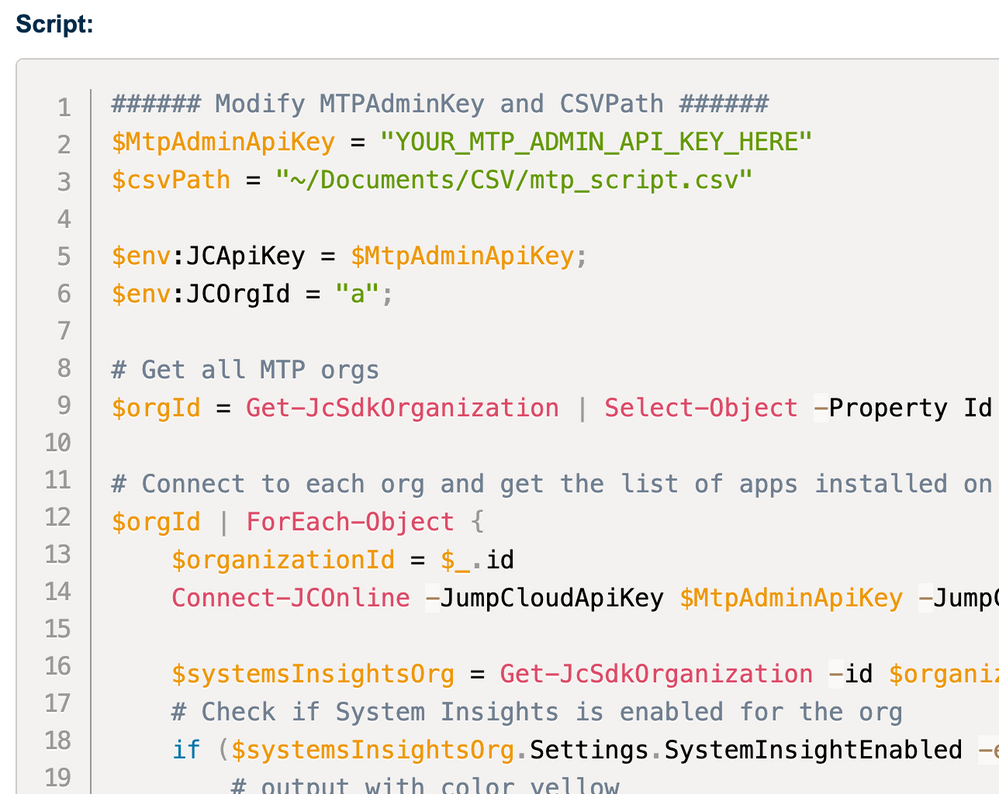[PowerShell] Script to pre-configure your Active Directory Integration (ADI) with JumpCloud
- Mark as New
- Bookmark
- Subscribe
- Mute
- Subscribe to RSS Feed
- Permalink
- Report Inappropriate Content
04-24-2024 08:22 PM
Hello
I got a little helper script for you to pre-configure your setup if you're integrating an Active Directory with JumpCloud.
As you might know, there are 3 different use cases in general:
- Extending your AD instance to support additional capabilities in the cloud and great flexibility.
- Minimizing your AD footprint without replacing your current implementation.
- Migrating away from AD completely.
Please read the Get Started with ADI article here.
My script here is focussed on establishing a Two-Way Sync between an AD and JC.
To configure such integration, read Configure the Active Directory Integration.
- AD Domain Admin credentials.
- Access to all Domain Controllers (DCs) or member servers in your AD domain.
- DCs or member servers have networking access to the internet and are able to communicate outbound (only) to console.jumpcloud.com over HTTPS port 443. The JumpCloud AD Import and Sync Agent services use SSL/TLS for all communication. If no network connectivity exists to JumpCloud, the ADI will fail to connect and not work properly.
- JumpCloud Organization for your company.
- A dedicated Administrator account in JumpCloud that is solely used for the ADI.
- We STRONGLY recommend installing and using LDAPS for the ADI.
The Installation Steps require you to have:
- Determined your Root User Container in AD
- The JumpCloud Security Group in AD
- AD Import Service Account with delegated read-only
- AD Sync Service Account with delegated CRUD, reset/force passwords, read all, modify group memberships
- Binaries for the Sync- and Import-Agent, API-Key, Org-ID and Connect-Key
My script helps you to get the setup post-install of the agents in just a few minutes (to be executed on the Domain Controller):
- Imports the Active Directory module
- Creates a JumpCloud security group if it does not exist
- Creates specified users (jcsync and jcimport) if they do not exist
- Optionally generates a self-signed certificate for LDAPS (or you choose this as the preferred method)
- Applies specified delegated permissions to the users jcsync and jcimport
Please note that in the this version of the script, both service accounts will have the same password. You can adjust the script to your own liking if desired.
Here's the script and you can find it on my Github as well:
<#
.SYNOPSIS
JumpCloud AD Integration Script to prepare the environment on your Domain Controller.
This script sets up users and groups in Active Directory and optionally creates a self-signed certificate for LDAP over SSL (LDAPS).
.DESCRIPTION
The script performs the following functions:
- Imports the Active Directory module.
- Creates a security group if it does not exist.
- Creates specified users if they do not exist.
- Optionally generates a self-signed certificate for LDAPS.
- Applies specified permissions to users.
.PARAMETER DistinguishedName
The distinguished name of the target organizational unit, i.e. 'CN=Users,DC=mydomain,DC=com'.
.PARAMETER GroupName
The name of the group to create, with 'JumpCloud' as the default.
.PARAMETER GroupDescription
A description for the group to be created.
.PARAMETER UserPrincipalNameSuffix
The suffix for the UserPrincipalName (e.g., '@mydomain.com').
.PARAMETER ServiceAccountPassword
The password for the service accounts, which will be converted to a secure string.
.PARAMETER CreateCert
Indicates whether to create a self-signed certificate for LDAPS. Accepts 'Y' or 'N'.
.EXAMPLE
.\ScriptName.ps1 -DistinguishedName "CN=Users,DC=mydomain,DC=com" -GroupName "JumpCloud" -GroupDescription "Description Here" -UserPrincipalNameSuffix "@mydomain.com" -ServiceAccountPassword "YourSecurePassword" -CreateCert "Y"
#>
# Load Active Directory module
Import-Module ActiveDirectory
# Collect input from user for required parameters and optional parameters with default values if not provided by the user
$DistinguishedName = Read-Host "Enter the Distinguished Name (DN) of the target OU, i.e.: 'CN=Users,DC=mydomain,DC=com'"
$GroupName = Read-Host "Enter the group name (default: 'JumpCloud')"
if ([string]::IsNullOrWhiteSpace($GroupName)) {
$GroupName = "JumpCloud"
}
$GroupDescription = Read-Host "Enter the group description"
$UserPrincipalNameSuffix = Read-Host "Enter the suffix for UserPrincipalName (e.g., '@mydomain.com')"
$ServiceAccountPassword = Read-Host "Enter the password for the service accounts" -AsSecureString
$CreateCert = Read-Host "Create a self-signed certificate for LDAPS? (Y/N)"
# Function to create AD group if it does not exist
function Create-ADGroup {
param(
[string]$Name,
[string]$Description,
[string]$OU
)
$existingGroup = Get-ADGroup -Filter "Name -eq '$Name'" -ErrorAction SilentlyContinue
if (-not $existingGroup) {
New-ADGroup -Name $Name -GroupScope Global -GroupCategory Security -Path $OU -Description $Description
Write-Output "Security group '$Name' created successfully."
} else {
Write-Output "Security group '$Name' already exists. Skipping creation."
}
}
# Function to create AD users if they do not exist
function Create-ADUsers {
param(
[string]$UPNSuffix,
[string]$OU,
[securestring]$Password
)
$users = @(
@{SamAccountName='jcsync'; UserPrincipalName="jcsync$UPNSuffix"; Name='JC Sync User'; Path=$OU},
@{SamAccountName='jcimport'; UserPrincipalName="jcimport$UPNSuffix"; Name='JC Import User'; Path=$OU}
)
foreach ($user in $users) {
if (-not (Get-ADUser -Filter "SamAccountName -eq '$($user.SamAccountName)'")) {
try {
New-ADUser @user -AccountPassword $Password -ChangePasswordAtLogon $false -PasswordNeverExpires $true -Enabled $true -ErrorAction Stop
Write-Output "User $($user.Name) created successfully."
} catch {
Write-Error "Failed to create user $($user.Name): $($_.Exception.Message)"
}
} else {
Write-Output "User $($user.Name) already exists. Skipping creation."
}
}
}
# Function to create a self-signed certificate for LDAPS (optional)
function Create-SelfSignedCertificate {
if ($CreateCert -eq 'Y') {
try {
# Get the DNS name of the computer
$computerDNSName = [System.Net.Dns]::GetHostEntry([System.Net.Dns]::GetHostName()).HostName
$certDNSName = $computerDNSName, $env:COMPUTERNAME
$cert = New-SelfSignedCertificate -DnsName $certDNSName -CertStoreLocation cert:\LocalMachine\My
$tempCertFile = [System.IO.Path]::GetTempFileName()
Export-Certificate -Cert $cert -FilePath $tempCertFile
$rootStore = "cert:\LocalMachine\Root"
Import-Certificate -FilePath $tempCertFile -CertStoreLocation $rootStore
Remove-Item $tempCertFile
Write-Output "Self-signed certificate for LDAPS created successfully. Waiting for a minute to apply the changes..."
Start-Sleep -Seconds 60
Write-Output "Done."
} catch {
Write-Error "Failed to create self-signed certificate: $($_.Exception.Message)"
}
}
}
# Main execution
Create-ADGroup -Name $GroupName -Description $GroupDescription -OU $DistinguishedName
Create-ADUsers -UPNSuffix $UserPrincipalNameSuffix -OU $DistinguishedName -Password $ServiceAccountPassword
Create-SelfSignedCertificate
Write-Output "Script execution completed. Please validate the Users, Group, Permissions and LDAPS (optional)."
Thanks for reading! 😉
- Juergen
- Labels:
-
API
-
PowerShell




